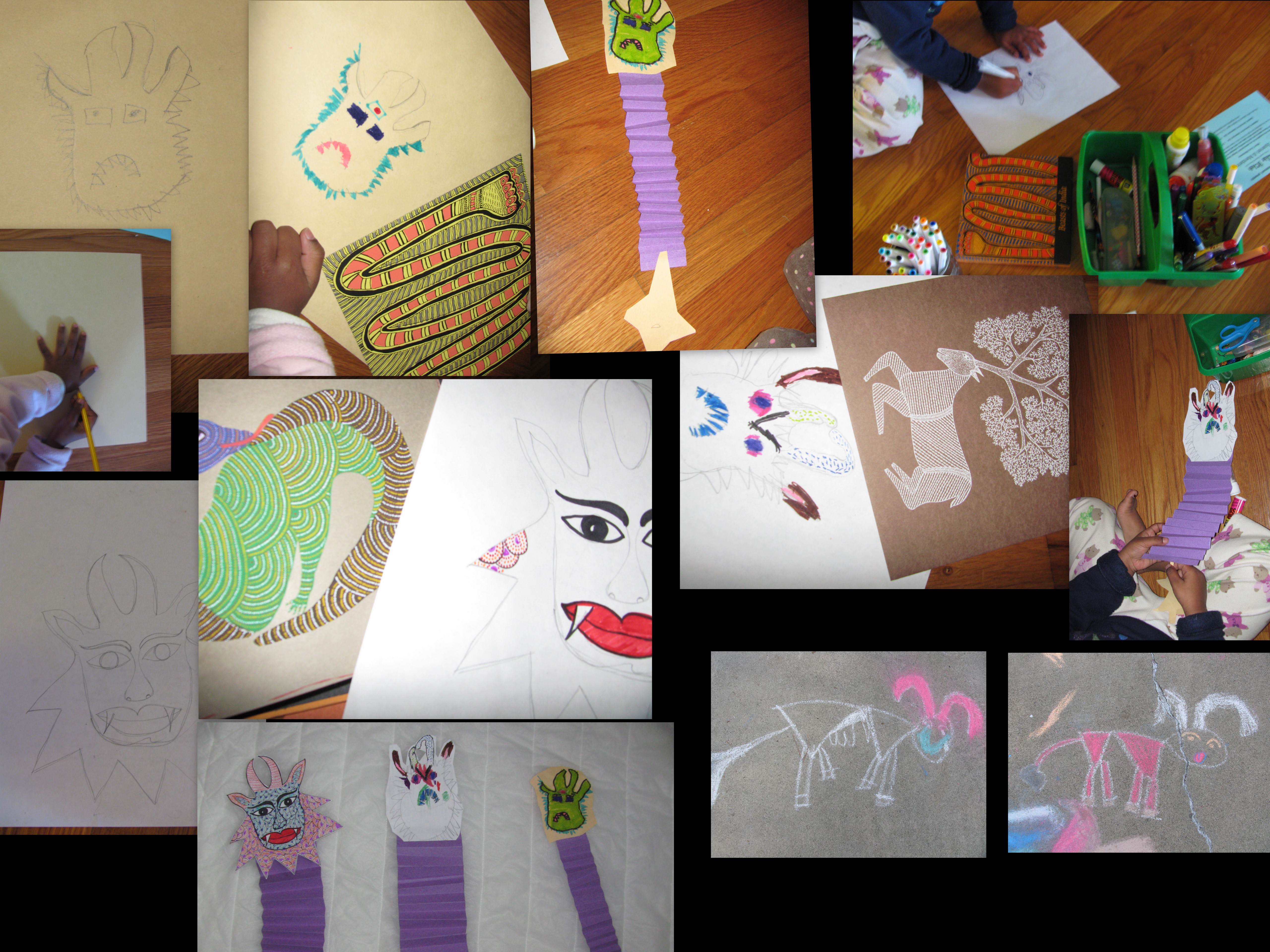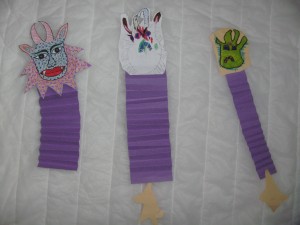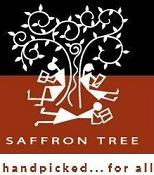Beasts Of India
Author: utbt17 Feb 2010
Edited to add: Submitted post for Shruti’s Artsy-Craftsy June 2001 Folk art challenge.
To play Feb’s “Guess the book” see the side bar.
FOLK ART.
The very first time I heard this term was in 2003. I was experimenting with various mediums. I took my Tanjore painting of Krishna and Balram to my oil painting class, people were impressed by the richness and details. That’s when some one popped the question, “Is this folk art? Some thing typical of India?”. Though I had no clue about the exact definition of folk art, some thing prevented me from saying yes. I thought hard and answered, “Well, it is more like traditional art, practiced in the southern part India.” Though I had answered the question, I had no idea about the difference between folk art and traditional art and why I chose the later term to describe my painting. But something was planted in my mind regarding the different art forms of Indian art. Ever since, people who have know me would have heard me say, “I am looking for books on Indian art that are intrinsically India.”
For the past couple of months I have been looking at Tara’s website, which by the way is my new pass time, and I must say that I am mesmerized. All their books have a unique theme and the vibrant book covers tempted me to hit the ‘Add To Cart’ button. It was at this point I happened to clean one of book storage bins and I almost squealed in delight. There, it was lying at the bottom of the bin was Tara’s BEASTS OF INDIA! I must have bought it in my recent India trip and must have completely forgotten about it or the book fairy must have paid me a visit. (In case if it is the book fairy, I don’t mean to sound ungrateful, thanks for this book and all that, but you really must look at the complete list. I so want to own DO! Also by Tara.)
The book has been reviewed for Saffron Tree. Find the review here.
How can we let this inspiration pass. So we combined it with the festive atmosphere of the Lunar New Year and Satish’s review of Everyone Knows What A Dragon Looks Like and we made our own paper dragons.
First what we talked about how every one imagined their dragons. Prominent features like big eyes, horns, bushy eye brows, sharp teeth, fire were thrown out. We all unanimously agreed that the dragon is scary and the color red must feature in the dragon.
We picked one style that inspired us to create our dragon. Chula wanted to combine Patachitra and Gond. The little one started with Madhubani and soon changed her mind. I was deeply attracted to Gond the minute I set my eyes on one. So I stayed with Gond till the end.
The hand with its fingers spread out can be a starter for many art forms. For the most part it eliminates the, “I can’t do it like you amma, can you do it for me?”. We traced our hands, leaving out the the thumb. We converted the index finger and the pinkie in to ears. The other two fingers became the horns.
It took me a good two hours to finish my dragon and I must say that it was deeply therapeutic. The little ones lost interest after the first fifteen minutes and they moved away. But they saw how much I was enjoying myself and came back to ‘help’. For the last 45 minutes they sat next to me, one holding the pens and one making sure that I did not miss the pattern. The critique from the little ones, “Well, he kind of looks friendly amma. Not scary at all. May be he is a she.” I did start out with the mental picture of the Yali, but the end result was very different.
I know that the books touched the girls because when I stepped out I saw that they had created out of side walk chalk a Warli inspired cow 🙂
With that I leave you with some pictures.

Dragon inspired by Beasts of India



 (No Ratings Yet)
(No Ratings Yet)
14 Responses for "Beasts Of India"
Cool!
UTBT SAYS: Thanks and your comment was in spam filter!!! What is with WP? Now I have to double chk spam?
Liked the imaginative art work 🙂
UTBT SAYS: Thanks Vibha and welcome here.
Phenomenal. I am deeply envious of people with appreciation of art. Don’t have too much but don’t see why this should stop my children! Thanks to you creative types, I should be able to find something of value to introduce to them.
Thanks! And the dragons are not scary – but then whos aid dragons must be fiery? 🙂
UTBT SAYS: Come on Poppy, every one comes with their own skill sets and you have your own to share with you kids.
Dragons need not be scary, but the girls wanted to draw a scary dragon. They are stuck with scary boy dragon image from the book ‘The paper bag princess’, so they were surprised with the friendly dragon that looks groomed 🙂
wow! that is really cool. and thanks for mentioning my blog entry.
Tara books are just awesome! Do! looks so good – the cost is what keeps me from not buying everything.
UTBT SAYS: We have always loved your reviews. Dragons are sure hit at home turf. Do you have Do! ? I would go green with envy.
Did you do the antler with tree-like horns? Awesome, that one.
The warli figures by kids are super cute.
UTBT SAYS: No, no, no, no….. Just the dragon face.
The deer is a Gond that came with the book. Chula is using it as a reference to do her dragon’s horns.
Warli is getting real close to my heart. It is so simple for kids to recreate!
This is awesome.. the warli cows are too cute! They should draw them on t-shirts, you know!
UTBT SAYS: Hmmmm, not a bad idea. Okay friends and family, expect warli t-shirts as gifts.
I am with Poppy on this… my artistic abilities are questionable. Thanks to these blogs … I am able to introduce Cantaloupe to this creative world.
UTBT SAYS: Says the lady who is giving keyboard recitals. I MUST do a post about our family’s musical abilities 🙂 Will do in April.
Fantabulous! I’ll go with Poppy, thanks to blogging, people like us can educate ourselves at least to the extent to be able to expose the little creative minds to the resources.
UTBT SAYS: I am furtively copying your crossword idea DDMom. That that person that that creative talent.
Oh, by the way – on warli art. I got D started with a music class(more like bhajans class and she is already killing everyone in the house with non-musical years with her Ganapathi Ganapathi and guru brahmha.. ) . Anyhoo – her music teacher’s house – she has a whole wall at the entrance with a purple background and warli art. Simply beautiful.
UTBT SAYS: D in music class? OMG, I need to hear her sing.
Lovely post! It’s great to see how books can spark off journeys of creativity.
Also, thanks for all the compliments over on our blog at http://tulikapublishers.blogspot.com/
It’s very encouraging to hear from readers who enjoy Tulika’s books:)
UTBT SAYS: Thanks for dropping by Malar.
Pretty neat. I have to try this sometime …
UTBT SAYS: Yes, we loved the book.
I have to buy this book.. and the gond style is exquisite !! 🙂
Will try with Lil P too. Thanks for linking in
UTBT SAYS: Shruti, one can never go wrong with Tara books. Gond is so detailed. I love it. Thanks for linking in.
Fabulously done! Love each piece ..esp the warli cows. It’s always so nice to involve kids & create something. They come up with so many unique ideas….wild imagination of kids’; I just love it!
Good Day!
Deepa
UTBT SAYS: Thanks for stopping by Deepa.
Came over from Shruti’s. You have a great place here. Totally loved the dragon.. it’s soooo intricate. Did you use paints??? You think I can do it with sketch pens? Am dying to make one for my son.
UTBT SAYS: Thanks for visiting. I used fine tip markers. All my art work has been devoid of real paints as I never know when I have to clean up in a moment’s notice. Guess markers must work well too, as long as the tip is fine.
Leave a reply